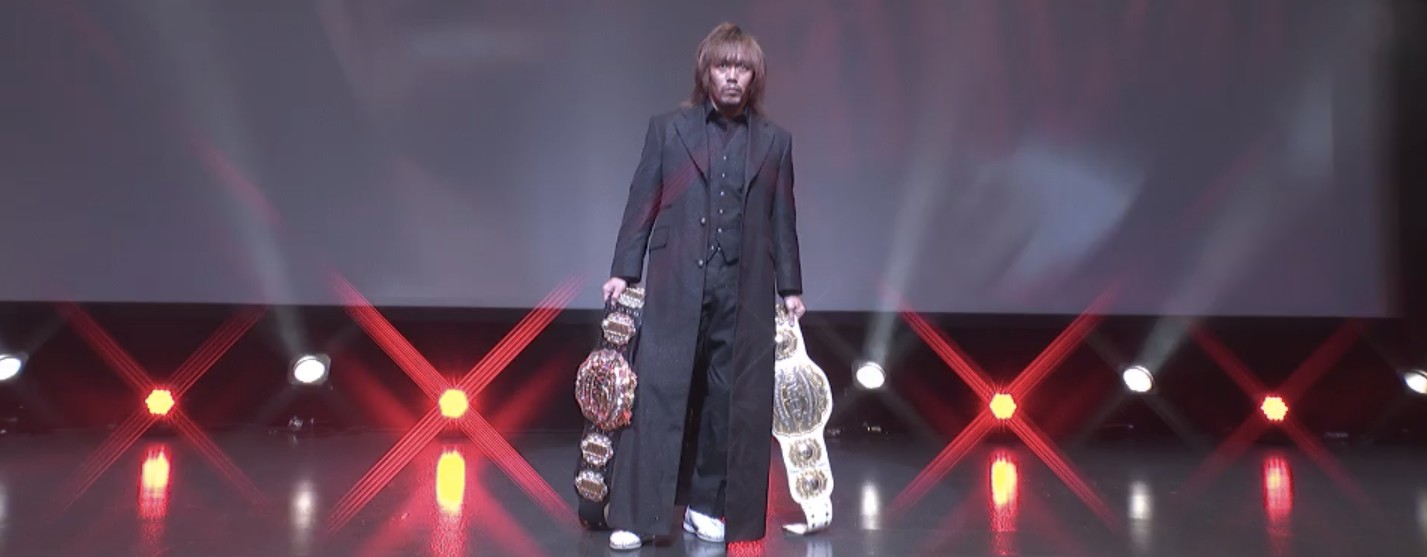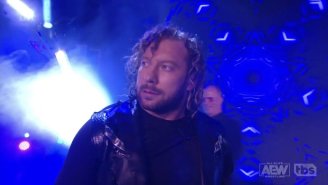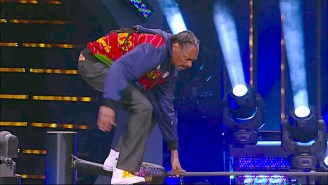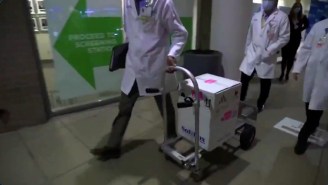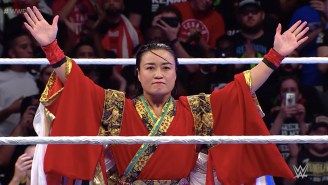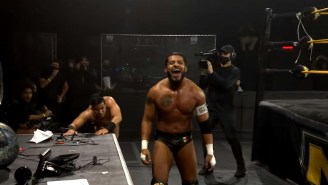Previously on NJPW: Ibushi and Tanahashi won the tag titles, Nakanishi retired, and Tiger Hattori also retired, but only from the referee part of his job. If you want an actual substantial recap of what was going in NJPW’s 2020 before coronavirus hit, I wrote one here!
You can watch New Japan Pro Wrestling shows on their streaming service, NJPW World, which costs 999 yen (about 9 USD.)
You can keep up with With Spandex on Twitter and Facebook, follow our home site Uproxx on Twitter, and even follow me on Twitter @emilyofpratt. Don’t forget to share this column on Facebook, Twitter, or whatever social media you use, and leave a comment with your thoughts on the show and/or article. All feedback is appreciated and will help us keep up the NJPW coverage now that there’s once again NJPW to cover.
Best: The Boys Are Back In Town
The NJPW Together Project Special was New Japan’s comeback over after 100 days on hiatus, and it’s named after the NJPW World programming series from the period when they weren’t putting on wrestling matches, a collection of talk shows, wrestlers talking about their favorite finishes and entrances, and Tele Pro-Wrestling, or wrestlers doing commentary on their old matches over Zoom. The card, which was a mystery until the beginning of the show, was that of a New Japan Road or Road To [Important Show Name] event, but after three months of no New Japan at all, it felt like a bigger deal than that.
NJPW leaned into the special occasional atmosphere and made this not just a preview for the New Japan Cup, but a celebration of all their hiatus programming and of their ability to responsibly end the hiatus. Japan isn’t New Zealand-level crushing COVID-19, but they’re on the list of countries handling the coronavirus exceptionally well, and New Japan’s return coincides with the end of the national state of emergency and the return of baseball.
That obviously doesn’t mean Japan is out of the woods, but it does mean that NJPW can play the “Let’s get through this together!” opening video and have Tanahashi come out at the beginning of the show and make his encouraging speech and it feels like an appropriate response to current events, not like this industry-leading company is trying to preach the necessity of “escapism” while sweeping the current state of the world under the rug far enough that their real-life response to it isn’t questioned. It’s easy to sit back and enjoy a bunch of six and eight-man tags because of both the knowledge the New Japan Cup is starting the following day and we’ll be getting singles, and because of overall goodwill towards the company.
NJPW also managed to make these matches easily digestible despite the absence of an audience, an entity whose critical importance to the medium of pro wrestling can’t be overstated. A huge part of up-and-coming wrestlers proving their worth is demonstrating their ability “to get over,” and crowd response is one of the most important factors in determining in the success of a character, match, move, promo, or angle. Plus, as anyone who’s been watching pandemic-era pro wrestling has seen by now, no-fans wrestling done wrong can slide into very silly or very eerie territory and not achieve what it was meant to do.
New Japan avoids the pitfalls of no-fans wrestling in the Together Special by consistently making the show feel very human. They don’t use faux-audience groups like WWE, AEW, and Dragon Gate, to name a few examples, have done, but they still manage to avoid the coldness that can often emanate from empty arenas. The venue, which looks like a new one for them, is only lit, as far as those watching on NJPW World can see, around the ring and the entranceway, and the setup doesn’t remind the viewer of the absence of an audience.
There’s also a lot a character and a fair amount of drama in every match besides maybe the opener, and that makes it easy to focus on what’s happening on the show rather than what isn’t. Another important element is the commentary team of Shinpei Nogami, Milano Collection A.T., and Jushin Thunder Liger, who sound enthusiastic throughout, filling the dead air and injecting what feels like genuine fan energy into the event, something that Liger also did as a guest commentator for Stardom’s first empty arena show. I’m still much more excited for NJPW to have (limited capacity) fans back than I am to watch more no-audience shows, but the Together Special at least demonstrates that New Japan knows how to work around that obstacle.
Best: Getting Through This Together
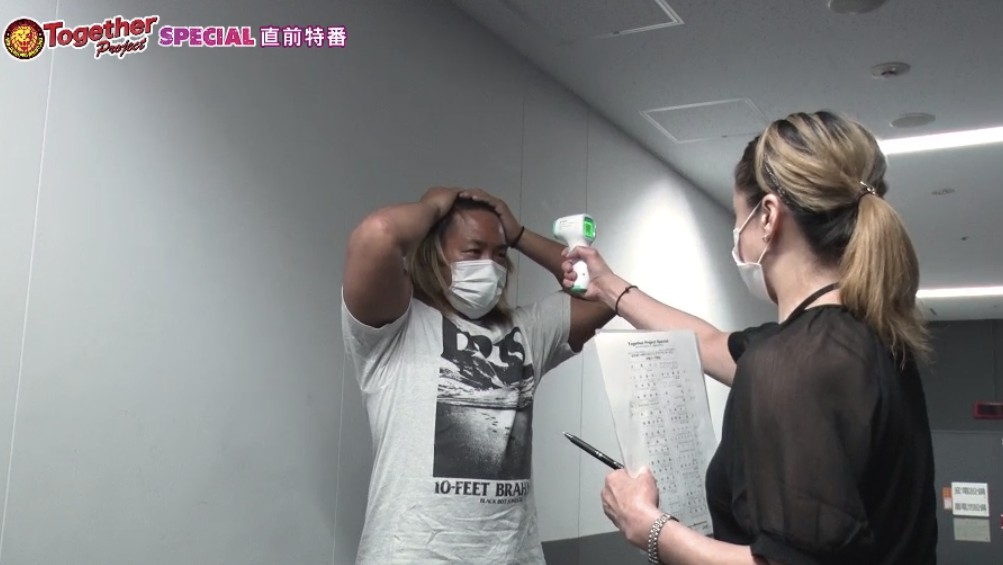
I promise I’ll get to the actual wrestling in the next section, but first I want to talk about how NJPW handled the pandemic part of running their first show after a pandemic-induced hiatus. While they celebrate circumstances improving enough for them to responsibly be able to resume shows, they don’t pretend like the coronavirus is gone. They released their detailed health and safety guidelines in Japanese and English ahead of the comeback, and they show their commitment to these during the pre-show (another thing that makes this feel like a special event; I can’t remember NJPW ever doing this format of pre-show before) and the main card.
We see wrestlers get off the bus wearing masks and getting their temperature taken backstage. The announcers are sitting at three separate tables with plexiglass in between them – something they make up for, again, with that extra enthusiasm and a little goofiness that feels fueled by a period of Staying Home. In what seems like overkill because they’ll be wrestling soon, tag teams being interviewed backstage stand about six feet apart. We’re also told that intermission for the two-and-a-half-hour event is for “cleaning and disinfection” and see people in plastic sanitizing the ring (something that AAA has also shown on their programming.) It might be the most this promotion full of neck bumps has ever promoted healthy behavior to their audience.
The acknowledgment of coronavirus isn’t one hundred percent solemn, and NJPW can pull off the more jokey references to COVID-19 because they’ve convincingly shown they are taking the situation seriously. Desperado “disinfects” his hands with Kanemaru’s whiskey, Bushi coyly forgoes spitting mist, and Yano wants to social distance from Bullet Club. These more light-hearted references to tough times add to the feeling that everyone involved in the show is going through them together, and the characters acknowledging the real world makes them feel just a little bit more human and easier to care about.
The First Young Lion Match In Three Months!
#NJPW is back🤼♂️‼️
第1試合はヤングライオン対決🦁‼️@tsuji_njpw 🆚 @GabrielKidd_ ‼️
ヤングライオンたちが激しいぶつかり合いを見せる💥‼️#njpwwolrd #njpw pic.twitter.com/BBED9ORuKl
— NJPW WORLD (@njpwworld) June 15, 2020
Like many NJPW shows of the past and many NJPW shows to come, the Together Project Special opens with a Young Lion match. It’s Gabriel Kidd vs. Yota Tsuji and it is fine! These two both look basically the same as when we last saw them. Kidd is still clearly at the bottom of the dojo hierarchy; everything he does in the ring is the slightly worse version of what his contemporaries are doing. But that doesn’t really mean anything about Gabe’s New Japan future; Tsuji looked like a colossally awkward goon for months after he debuted, and now he looks really good in the ring and it’s easy to visualize a successful future of him. NJPW probably could have started this show in a more exciting way even if they just opened with a bunch of old guys in a tag match instead, but Kidd vs. Tsuji worked as a warmup.
Best: Stone Pitbull Comes Out Of Cage, Does Just Fine
#NJPW is back🤼♂️‼️
第2試合はタッグマッチ‼️「NEW JAPAN CUP」の前哨戦‼️
石井智宏 & @YuyaUemura_njpw 🆚 @ElDesperado5 & @kmaru0923 ‼️
両陣営ゴング前からいきなり激突💥‼️#njpwworld #njpw pic.twitter.com/CJNZ53Urd8
— NJPW WORLD (@njpwworld) June 15, 2020
The first Real Match of the show, and I think the second-best of the whole thing behind the main event, is Yoshinobu Kanemaru and El Desperado vs. Tomohiro Ishii and Yuya Uemura, and it’s a strong tag match with a bit of everything. There’s quality tag team wrestling from the former junior champs, Ishii being a badass, Desperado being the best version of himself as both a character and a wrestler, and Uemura bursting with the aggression and focus of someone who was just cooped up in the dojo for months with nothing to do but train and put on like fifteen pounds of muscle.
This is the match that makes it feel like New Japan is really back. It also makes the upcoming Ishii vs. Despy match look like a reason to tune in again – and to expect Desperado to try to submit Ishii in it after strategically working one of his knees.
Worst: NJPW, Characters Welcome
#NJPW is back🤼♂️‼️
第3試合は本隊&CHAOS vs BULLET CLUBの8人タッグマッチ‼️@YTR_CHAOS & @510njpw & @YOSHIHASHICHAOS & 本間朋晃 🆚 高橋裕二郎 & @taiji_ishimori & 外道 & @REAL_JADO ‼️
リング内外で大乱闘が繰り広げられる‼️#njpwworld #njpw pic.twitter.com/9ToQwA0Kaf
— NJPW WORLD (@njpwworld) June 15, 2020
The worst match of this show on paper was Jado, Gedo, Taiji Ishimori, and Yujiro Takahashi vs. Hirooki Goto, Toru Yano, Yoshi-Hashi, and Tomoaki Honma, and it completely lived up to expectations. The rosiest of rose-colored classes could not make this match good.
It definitely has its upsides – the weirdness of the Bullet Club team feeling more like heel-era Chaos group, Ishimori showing up looking like the human embodiment of a sports car, and the commentary team’s level of enthusiasm for Kokeshis – but it drags, the wrestling is mostly not great, and it feels even lower stakes than the other matches on the card because of how low-level most of the wrestlers involved are. Anyone would be forgiven for using this as their pee break match, then coming back to discover that the show had a built-in pee break.
New Type Of Guy Alert
The Together Special also includes, just before intermission, a vignette for THE GRANDMASTER, a man who does martial arts in a bamboo forest. Everything about this immediately makes my brain think “Donnie Yen.” The most popular theory about this guy’s identity, and the one that I subscribe to, is that he’s Hirai Kawato, who seems like he quietly finished up his CMLL excursion earlier this year. Every time I decided to check out how Kawato-San was doing in Mexico the answer seemed to be “very badly,” so he could easily feel like he has a lot of “overcome,” which fits the dramatic narration.
Best: Have You Heard The Good News About The New Japan Cup?
#NJPW is back🤼♂️‼️
第4試合は本隊 🆚 #LIJ の6人タッグマッチ‼️@TENZAN323 & @cozy_lariat & @taguchiryusuke 🆚 @151012EVIL & @seiyasanada & @BUSHI_njpw‼️
NEW JAPAN CUP2試合の前哨戦‼️#njpwworld #njpw pic.twitter.com/cVOQ7auenu
— NJPW WORLD (@njpwworld) June 15, 2020
The show returns from intermission with a stronger second half (still New Japan Road show strong and not, like, Dominion strong), starting with former 6-Man champs Bushi, Sanada, and Evil vs. old married couple TenCozy and their weird next-door neighbor Ryusuke Taguchi. This match is elevated, like the show as a whole, by it just being really nice to see everybody back doing their thing. Also, by the sheer amount of yelling from wrestlers and commentary.
Evil, with his mannerisms and cocky pin attempts, looks like the character most out to make a point and establish himself here, but Taguchi is the MVP performer, pulling off every comedic moment and hip attack sequence with the freshness of a guy who just had three months off, but somehow none of the ring rust.
#NJPW is back🤼♂️‼️
第5試合、本隊🆚鈴木軍の8人タッグマッチ‼️
NEW JAPAN CUP、3試合の前哨戦‼️@tanahashi1_100 & @ibushi_kota& @nagata769 & @GBH_makabe 🆚 @suzuki_D_minoru & @taichi0319 & @zacksabrejr & @DoukiPerros‼️
ゴング前から鈴木軍が奇襲‼️一体どんな展開を見せるのか⁉️#njpwworld pic.twitter.com/VrtMa2KnDg— NJPW WORLD (@njpwworld) June 15, 2020
The Suzukigun (Douki, Minoru Suzuki, Zack Sabre Jr., and Taichi) vs. Togi Makabe, Kota Ibushi, Hiroshi Tanahashi, and Yuji Nagata match is just as fun, with the bonus of more interpersonal drama. Suzuki and Nagata kick off the match like they just want to go one-on-one right then and there and they sell the heck out of their upcoming singles match. Tanahashi and Taichi work well together too, and Taichi of course trying to neg Tana for having any percentage of body fat when they have almost the exact same torso (when Tana’s not flexing) is a great post-match bit.
ZSJ and Ibushi keep their rivalry alive and make it look like the same people who were very into past ZSJ-Ibushi matches will enjoy their next one. But also, man, Zack really shows off all the cons of him being a wrestler in about a minute here with his insistence on getting into strike battles and his tendency to weirdly no-sell high-impact moves and transition them into submissions, all things he does while being very physically non-threatening.
This match also includes possibly the weirdest moment of the entire show: Makabe’s actual theme playing on the NJPW World broadcast. Did they actually spring for the rights to it after losing however much money they lost from like 50 show cancelations or was this a mistake? This might be the number one thing I’m looking forward to seeing from Makabe vs. Tsuji now.
Best: The Main Event Level Main Event
#NJPW is back🤼♂️‼️
第6試合、#CHAOS 🆚 #LIJ の6人タッグマッチ‼️@rainmakerXokada & @njpwShowT & @njpwyohei_k 🆚 @s_d_naito & @Takagi__Shingo & @TIMEBOMB1105 ‼️
いきなりオカダと内藤がマッチアップ💥‼️
一体どんな展開を見せるのか⁉️#njpwworld pic.twitter.com/XswqtuuPPx— NJPW WORLD (@njpwworld) June 15, 2020
The Together Project Special finishes up with L.I.J. (Tetsuya Naito, Hiromu Takahashi, and Shingo Takagi) vs. Kazuchika Okada, Sho, and Yoh in a six-man tag with substance. If you weren’t excited by this combination of people ahead of the match, the entrances reveal three (3!!) new gears – and I’m obsessed with Yoh’s streetwear-ish entrance getup and whatever thought process inspired Sho to get Jay White’s old haircut. When the wrestling starts, it’s quickly some of the best on the show, with a Naito vs. Okada opening sequence with some tension, Sho vs. Shingo stoking each other’s aggression, and quality teamwork from Roppongi 3K and the Los Ingos trio.
The only time someone doesn’t look great is when Naito hits his new pre-finisher. Him not having to do two Destinos in a row to end matches could be good, but this new DDT-variation-thing causes him to land hard flat on his back, and it the impact makes it look like it’s harder for him to get up from this than from after doing most kinds of DDTs. Maybe the move will grow on me or we’ll see it evolve a little, but my main impression from its first use was that could it be easily reversed into a pin in a way that would make Naito look stupid.
The quality main event is followed by the introduction of some intra-L.I.J. drama just in time for tournament season. Like Sanada ahead of the 2018 G1 and Evil with the 2019 G1, Shingo and Hiromu (to a lesser extent) are being angsty about fighting their friends. It’s not inevitable that they will, but they really, really want to get to the point where they have to, so it’s a slightly different dynamic than G1 drama. And Hiromu and Takagi, with their very different personalities and wrestling styles, finally interacting is a win, and even though L.I.J. vs. L.I.J. has always worked out in the past, the group’s spirit of internal competition is always fun and tense to watch.
Overall, the Together Project Special is an event full of entertaining wrestling that’s produced in a way that hides its limitations, and it successfully builds excitement for shows to come. The show makes it easy to feel good about New Japan’s comeback and to want to tune in for more from the King of Sports.

